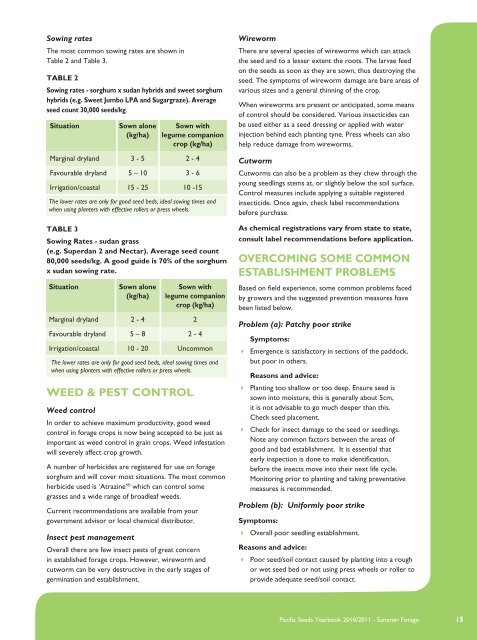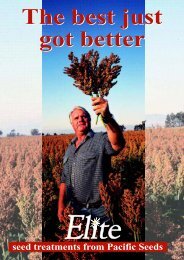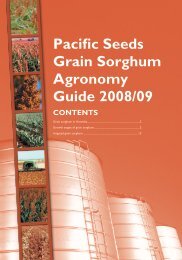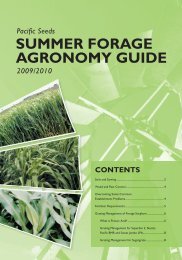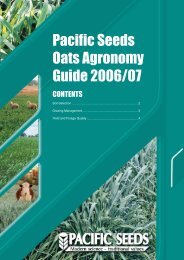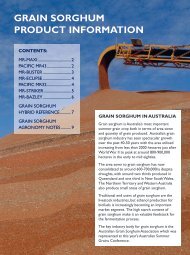SUMMER FORAGE pROdUct inFORMAtiOn - Directrouter.com
SUMMER FORAGE pROdUct inFORMAtiOn - Directrouter.com
SUMMER FORAGE pROdUct inFORMAtiOn - Directrouter.com
- No tags were found...
Create successful ePaper yourself
Turn your PDF publications into a flip-book with our unique Google optimized e-Paper software.
Sowing rates<br />
The most <strong>com</strong>mon sowing rates are shown in<br />
Table 2 and Table 3.<br />
TABLE 2<br />
Sowing rates - sorghum x sudan hybrids and sweet sorghum<br />
hybrids (e.g. Sweet Jumbo LPA and Sugargraze). Average<br />
seed count 30,000 seeds/kg.<br />
Situation Sown alone Sown with<br />
(kg/ha) legume <strong>com</strong>panion<br />
crop (kg/ha)<br />
Marginal dryland 3 - 5 2 - 4<br />
Favourable dryland 5 – 10 3 - 6<br />
Irrigation/coastal 15 - 25 10 -15<br />
The lower rates are only for good seed beds, ideal sowing times and<br />
when using planters with effective rollers or press wheels.<br />
TABLE 3<br />
Sowing Rates - sudan grass<br />
(e.g. Superdan 2 and Nectar). Average seed count<br />
80,000 seeds/kg. A good guide is 70% of the sorghum<br />
x sudan sowing rate.<br />
Situation Sown alone Sown with<br />
(kg/ha) legume <strong>com</strong>panion<br />
crop (kg/ha)<br />
Marginal dryland 2 - 4 2<br />
Favourable dryland 5 – 8 2 - 4<br />
Irrigation/coastal 10 - 20 Un<strong>com</strong>mon<br />
The lower rates are only for good seed beds, ideal sowing times and<br />
when using planters with effective rollers or press wheels.<br />
Weed & pest control<br />
Weed control<br />
In order to achieve maximum productivity, good weed<br />
control in forage crops is now being accepted to be just as<br />
important as weed control in grain crops. Weed infestation<br />
will severely affect crop growth.<br />
A number of herbicides are registered for use on forage<br />
sorghum and will cover most situations. The most <strong>com</strong>mon<br />
herbicide used is ‘Atrazine’ ® which can control some<br />
grasses and a wide range of broadleaf weeds.<br />
Current re<strong>com</strong>mendations are available from your<br />
government advisor or local chemical distributor.<br />
Insect pest management<br />
Overall there are few insect pests of great concern<br />
in established forage crops. However, wireworm and<br />
cutworm can be very destructive in the early stages of<br />
germination and establishment.<br />
Wireworm<br />
There are several species of wireworms which can attack<br />
the seed and to a lesser extent the roots. The larvae feed<br />
on the seeds as soon as they are sown, thus destroying the<br />
seed. The symptoms of wireworm damage are bare areas of<br />
various sizes and a general thinning of the crop.<br />
When wireworms are present or anticipated, some means<br />
of control should be considered. Various insecticides can<br />
be used either as a seed dressing or applied with water<br />
injection behind each planting tyne. Press wheels can also<br />
help reduce damage from wireworms.<br />
Cutworm<br />
Cutworms can also be a problem as they chew through the<br />
young seedlings stems at, or slightly below the soil surface.<br />
Control measures include applying a suitable registered<br />
insecticide. Once again, check label re<strong>com</strong>mendations<br />
before purchase.<br />
As chemical registrations vary from state to state,<br />
consult label re<strong>com</strong>mendations before application.<br />
Over<strong>com</strong>ing some <strong>com</strong>mon<br />
establishment problems<br />
Based on field experience, some <strong>com</strong>mon problems faced<br />
by growers and the suggested prevention measures have<br />
been listed below.<br />
Problem (a): Patchy poor strike<br />
Symptoms:<br />
Emergence is satisfactory in sections of the paddock,<br />
but poor in others.<br />
Reasons and advice:<br />
Planting too shallow or too deep. Ensure seed is<br />
sown into moisture, this is generally about 5cm,<br />
it is not advisable to go much deeper than this.<br />
Check seed placement.<br />
Check for insect damage to the seed or seedlings.<br />
Note any <strong>com</strong>mon factors between the areas of<br />
good and bad establishment. It is essential that<br />
early inspection is done to make identification,<br />
before the insects move into their next life cycle.<br />
Monitoring prior to planting and taking preventative<br />
measures is re<strong>com</strong>mended.<br />
Problem (b): Uniformly poor strike<br />
Symptoms:<br />
Overall poor seedling establishment.<br />
Reasons and advice:<br />
Poor seed/soil contact caused by planting into a rough<br />
or wet seed bed or not using press wheels or roller to<br />
provide adequate seed/soil contact.<br />
Pacific Seeds Yearbook 2010/2011 - Summer Forage 15


